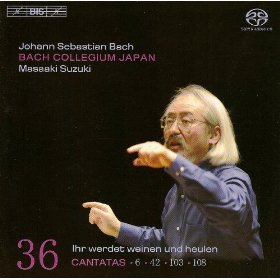Bach – Cantatas Vol.36 (Suzuki)
Bach – Cantatas Vol.36 (Suzuki)

01 – 07. Am Abend aber desselbigen Sabbats, BWV 42 08 – 13. Ihr werdet weinen und heulen, aber die Welt wird sich Freuen, BWV 103 14 – 19. Es ist euch gut, das ich hingehe, BWV 108 20 – 25. Bleib bei uns, denn es will Abend werden, BWV 6 Yukari Nonoshita (Soprano), James Gilchrist (Tenor), Robin Blaze (Countertenor), Dominik Wörner (Bass) Bach Collegium Japan Masaaki Suzuki - conductor
Like its fellows from the year 1725, Am Abend aber desselbigen Sabbats, BWV 42, is a chorale cantata. It takes the bulk of its inspiration from an existing hymn-tune and develops the music from there. First performed on 8 April 1725, it is typical in taking the chorale theme and exploring its musical potential before releasing it in clear identity in the final chorale movement. Some scholars believe that Bach’s congregation would have known these tunes well enough to join in the when the cantata came to its close.
This cantata is exceptional for 1725, since Bach found the associated Biblical verse, of the private appearance of the risen Christ to the disciples, unsuitable for a choral setting. Instead he began with a substantial da capo instrumental movement. As ever Suzuki captures exactly the right tempo for this, and the balance between winds, strings is perfect. Perhaps Robin Blaze is recorded a little closely in his aria. However he sings most expressively in this, one of the most extended of all Bach’s da capo movements, at more than 13 minutes. The other aria in this piece is most effectively delivered by the bass, Dominik Wörner.
BWV 103, Ihr werdet weinen und heulen (We shall weep and lament, but the world shall rejoice) was written for Jubilate Sunday, 22 April 1725. There is a most affecting opening chorus, replete with subtle woodwind counterpoints to the string ensemble. These are beautifully balanced in the texture by Suzuki, as structure and expressive meaning are so subtly intertwined. Again the solo voices are on top form, with James Gilchrist delivering his splendid aria to perfection.
From one volume to the next Suzuki assembles an array of forces that seems perfectly judged for these cantatas, and the SACD BIS sound helps articulate the musical delivery so convincingly. The chorus numbers twelve, and there is always plenty of atmosphere in the acoustic of the Kobe Shuin Women’s University Chapel. There is no opening chorus or sinfonia in BWV 108, Es ist euch gut, daß ich hingehe (It is right that I go away), rather the music begins with Dominik Wörner’s bass aria, and the instrumental ensemble balances the voice most effectively, as Jesus sings his song of farewell. James Gilchrist’s tenor aria is heard with a wonderful obbligato violin, but possibly its most effective aspect as realized here is the strong underlying pulse of the ostinato rhythm.
In BWV 6, there is another cantata from the closing weeks of Bach’s second year cycle, in other words from the period around Easter. The background is another story concerning the return of the resurrected Christ and his unexpected appearance before (two of) the apostles. Here the musical construction is more distinctive, perhaps, than in the other cantatas on the disc. The opening chorus, for example, is cast in French overture form, with a faster fugal central section at the centre. Bach skilfully develops the two fugue subjects, and as ever Suzuki judges the balancing and projection of the themes with aplomb. Robin Blaze is on top form in his alto aria, combining so imaginatively with the obbligato decoration of the oboe da caccia. Later in the cantata the cello piccolo shares material with the soprano, the excellent Yakari Nonoshita, in one of Bach’s most distinctive and unusual voice-and-instrument relationships.
The closing chorale movements are simply delivered in all four of these cantatas, making the musical and expressive point all the more effectively. This is another splendid achievement by Masaaki Suzuki and Bach Collegium Japan.---Terry Barfoot, MusicWeb International
download: uploaded ziddu 4shared divshare depositfiles








